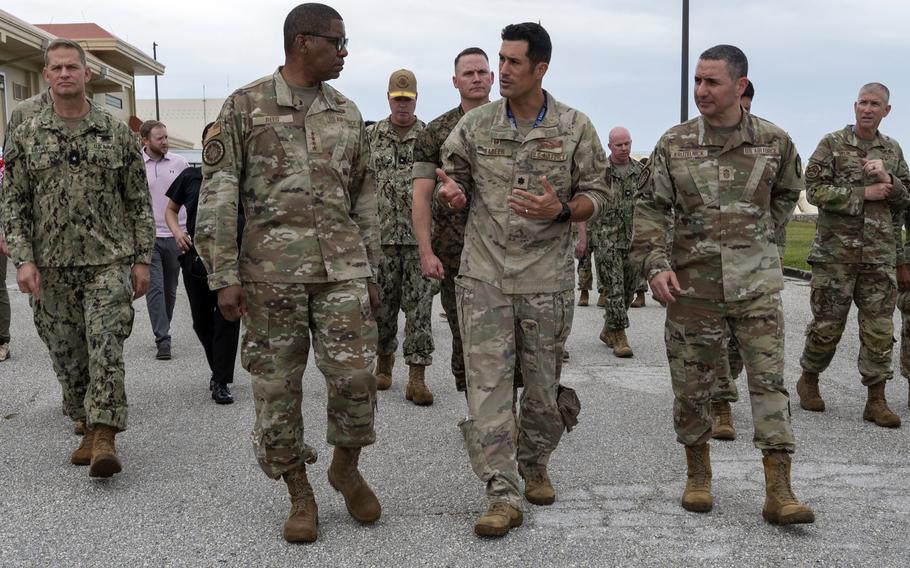
The head of U.S. Transportation Command, Gen. Randall Reed, center left, visits Andersen Air Force Base, Guam, June 3, 2025. (Jordan Garner/U.S. Air Force)
Multiple logistics exercises this summer will test and enhance U.S. forces’ airlift and sealift capabilities across the Indo-Pacific, the head of U.S. Transportation Command said Friday.
“We’ll test the current logistics architecture and infrastructure, which provides sustained freedom of maneuver in the region and for the joint force,” Gen. Randall Reed told reporters during an online press conference.
The drills come at a time of heightened tensions, as China rapidly expands its military, constructs bases in disputed South China Sea territory and threatens to invade or blockade Taiwan.
Reed is on a multiweek tour that includes stops in Guam, the Philippines, Japan and South Korea. Photographs released by the Defense Department show him meeting with officials at Andersen Air Force Base, Guam, on Tuesday and in Manila on Thursday. His next stop is South Korea, he said.
While Reed did not reveal many specifics about the upcoming drills, he confirmed one would be Mobility Guardian, a biennial exercise held in the Indo-Pacific for the first time in 2023.
That iteration involved forces from Australia, the United Kingdom, Canada, New Zealand, France and Japan. Together, they moved 15,000 U.S. and international troops using 70 aircraft for resupply missions, aerial refueling, and medical evacuations across a 3,000-mile training area.
This year’s exercise series aims to demonstrate the ability to rapidly mobilize and deploy forces from the U.S. to spots throughout the Indo-Pacific, Reed said.
“These exercises will be very key to allow us to test tactics, techniques and procedures with allies and partners, and allow us to enhance our connectivity across various locations,” he said.
The U.S. military is committed to modernizing its sealift and airlift fleets, Reed said, adding that he’s been vocal about the need for more sealift capability.
“The fleet that we have is capable but aging, and quite simply, we need to get newer, more modern ships for the crews to operate,” he said. “We’re pushing to make sure that we can increase our capacity to move the personnel and equipment rapidly across this vast region.”
The summer drills will help Transportation Command evaluate its capabilities while deepening relationships with allies and partners, Reed said.
“Together, with continued support, we’ll retain the ability to respond to whatever, whenever we’re needed,” he said. “What we’re looking to do is to make sure that, simply, everyone can communicate with each other, that we can transport our goods, that we can sustain, and that we can reset at the end.”
The general said he has been talking to officials and multinational service members about ways to enhance collaboration, deter aggression and increase readiness for any potential crisis.
“Maintaining and expanding our relationships in the region is essential as we cooperate and collaborate to ensure a swift U.S. response to any future humanitarian-aid and disaster-relief operation while also countering threats to international peace and security, whether they originate from state actors or violent extremist groups,” he said.